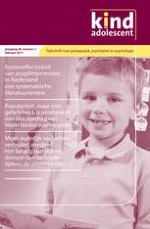01-06-2001 | Artikelen
Voorspellen en verklaren van emoties bij dove kinderen
Gepubliceerd in: Kind en adolescent | Uitgave 2/2001
Log in om toegang te krijgenSamenvatting
Recente bevindingen tonen dat dove kinderen in vergelijking met horende kinderen andermans emoties verschillend verklaren. Mogelijk hebben dove kinderen andere communicatiepatronen ontwikkeld door hun moeilijke positie in een horende omgeving. Uit dit onderzoek blijkt dat 47 negen- tot elfjarige enkelvoudig gehandicapte dove kinderen – in tegenstelling tot een horende controlegroep (n = 67) – in de emotieverklaringen eenzijdig gericht zijn op de vervulling van wensen. Daarbij tonen zij maar weinig aandacht voor achterliggende oorzaken die tot de negatieve uitkomst hebben geleid. Bovendien geven zij weinig blijk rekening te houden met de vraag of de geadresseerde iets aan de situatie kan veranderen.
